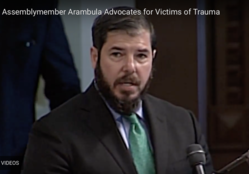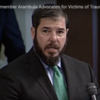R to L: Jeff Hild, Rep. Geran Tarr, Afomeia Tesfai
_____________________________________________________________________
The planned agenda for the “Advancing Trauma-Informed Public Policy through Effective Advocacy” workshop at the 2018 ACEs Conference: Action to Access went out the window when an unexpected guest— California Assemblymember Joaquin Arambula, MD—was invited to open the session and join the other participants in lively exchanges about their advocacy experiences and perspectives on hot button issues such as parental separation and econom ic supports for families. As a physician, Arambula said that the trauma caused by placing people in cages at the border violated the principle in medicine “First, do no harm.” In the question and answer segment, he praised the strategies to prevent child abuse and neglect as outlined in a CDC technical package for distilling and elevating the fundamental supports needed by families to thrive.
ic supports for families. As a physician, Arambula said that the trauma caused by placing people in cages at the border violated the principle in medicine “First, do no harm.” In the question and answer segment, he praised the strategies to prevent child abuse and neglect as outlined in a CDC technical package for distilling and elevating the fundamental supports needed by families to thrive.
With the goal of strengthening participants’ understanding of the policy development and implementation process, panelists used two cases studies—one national and one state—to demystify the intricacies of the legislative process.
Jeff Hild, policy director, Milken Institute School of Public Health at The George Washington University, presented a case study of how trauma-informed provisions first included the Heitkamp-Dubin “Trauma-Informed Care for Children and Families Act, S. 774” made their way into the recently passed opioid legislation (H.R. 6). (See this article in ACEs Connection for a description of this process). I then presented an overview of trends in state legislation, providing a context for the second case study on a major policy victory in Alaska. Some of the information on legislation came the National Conference of State Legislatures’ (NCSL) tracking of bills related to adverse childhood experiences. This resource—available on its website—reflects how the issue of trauma-informed policy has gained traction in recent years with both legislators and the public.
Rep. Geran Tarr, who was elected to the Alaska House of Representatives in 2012, said working to make Alaska trauma-informed is a passion for her because of the district she represents and her own personal history. She described her district as low-income, diverse, and too familiar with gun violence. She also said—in her first public declaration—that her ACE score is either 9 or 10. If the ACE includes jail as well as prison, her score is 10.
Tarr presented the featured state level case study on how SB 105 was enacted in the 2018 session to require state policy to:
“acknowledge and take into account the principles of early childhood and youth brain development and, whenever possible, consider the concepts of early adversity, toxic stress, childhood trauma, and the promotion of resilience through protective relationships, supports, self-regulation, and services.”
Tarr described how another bill, House Concurrent Resolution 2, appeared to be failing for the second try when a last minute opportunity emerged to add the language to a bill that was moving through the legislature. The end result is that the language is now in statute, giving it more authority than if passed as a resolution. Already, state agency heads have met to discuss how the provision will be implemented.
The advocacy of the Alaska Resilience Initiative (ARI) in this legislative victory was also included in Rep. Tarr’s case study and is detailed in an ACES Connection story on the passage of SB 105 by ARI Director Laura Norton Cruz. A policy brief, written by Andrea Blanch, PhD, “Toward a Trauma-Informed, Resilient, and Culturally-Responsive Alaska,” is also available on the ARI website, along with a detailed description of how the SB 105 victory was achieved.
The original plan for the workshop included roundtable discussions with suggested topics such as how to address a specific policy goal, how to develop their advocacy skills, or get organized to undertake legislative action. The session moderator, Afomeia Tesfai, policy and advocacy manager, Center for Youth Wellness, encouraged participants to build on what they learned at the workshop to develop local strategies with other advocates in their communities. A handout to guide these discussions was provided.
Many of the workshop strategies and specifics of legislative initiatives also were covered in a webinar series—State Policy Approaches to Address Childhood Adversity— sponsored by 4CA (the California Campaign to Counter Childhood Adversity) archived here. A final webinar will be announced soon that addresses specific strategies for California.


Comments (1)